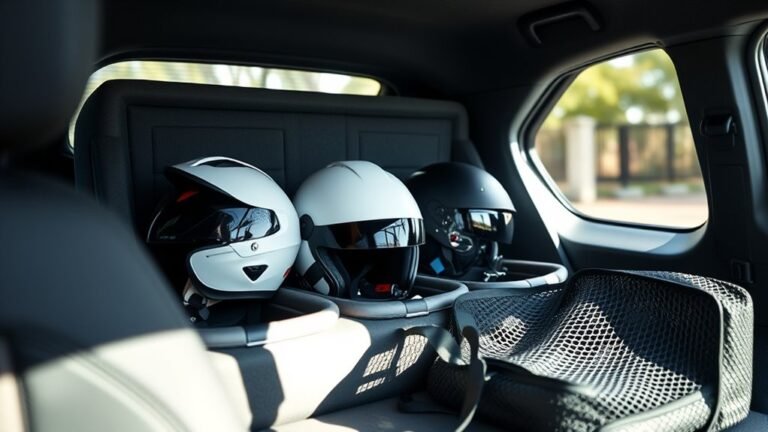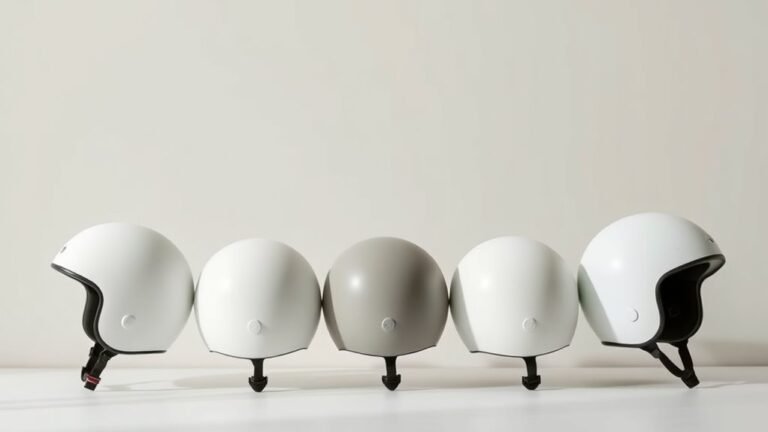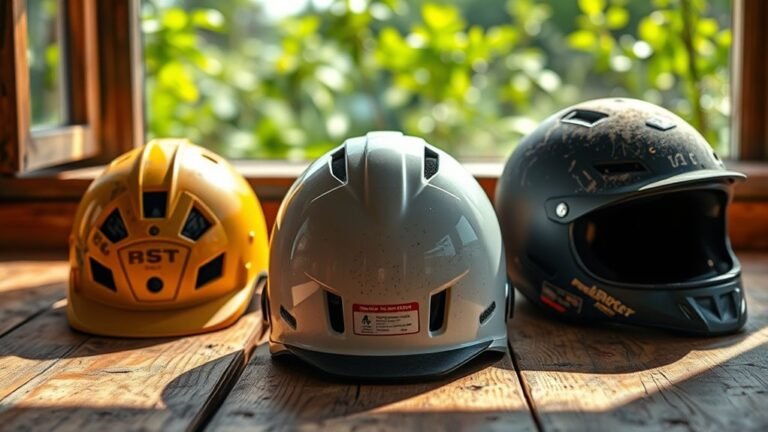Bicycle Helmet Safety Standards Explained
Bicycle helmet safety standards are essential for protecting your head during rides. Helmets that comply with ASTM and CPSC standards greatly reduce the risk of head injuries, offering impact resistance and durability. Proper certification means the helmet has undergone rigorous testing, ensuring it can withstand various crash scenarios. Remember, not all helmets are created equal; understanding features like fit, ventilation, and materials can make a big difference in safety. You’ll discover more insights on helmet selection and safety features.
Understanding Helmet Safety Standards
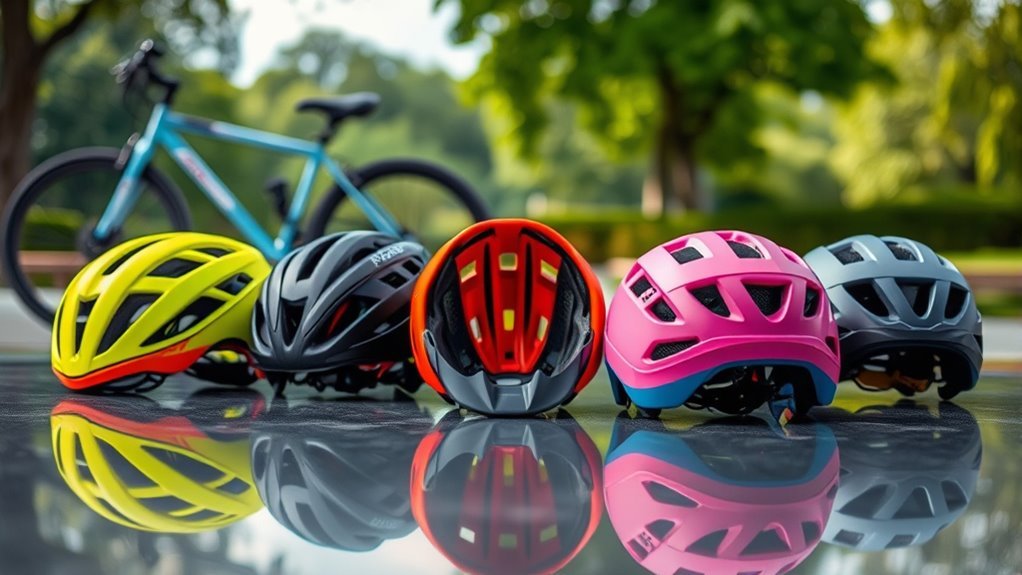
When you choose a bicycle helmet, it’s important to understand safety standards, as they guarantee the helmet provides effective protection. Various helmet materials, such as polycarbonate and expanded polystyrene, play a vital role in absorbing impact, enhancing your safety during rides. Look for helmets that incorporate safety innovations, like MIPS (Multi-directional Impact Protection System), which helps reduce rotational forces during crashes. These advancements not only improve safety but also cater to your desire for freedom on the road. By selecting a helmet that meets or exceeds safety standards, you’re making a smart choice that prioritizes your well-being without sacrificing comfort or style. Remember, a well-protected ride contributes to the joy of cycling, allowing you to explore the world confidently.
The Importance of Certification
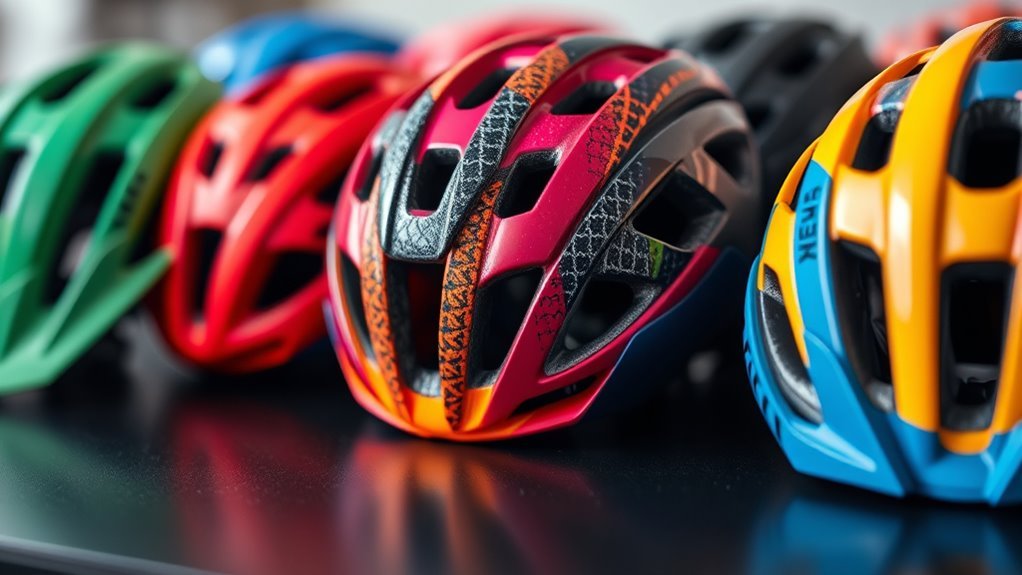
Although you might be tempted to grab any helmet that looks good, helmet certification is essential for ensuring your safety on the road. Certified helmets meet rigorous safety regulations that test their ability to protect your head during an impact. When you choose a certified helmet, you’re not just picking a trendy accessory; you’re selecting a piece of equipment that can save your life. Uncertified helmets may lack the necessary protection and could lead to serious injury in an accident. By prioritizing helmet certification, you’re making an informed choice that supports your freedom to ride confidently. So, next time you shop for a helmet, remember: safety should always come first, and certification is the key to true protection.
Key Safety Standards to Know
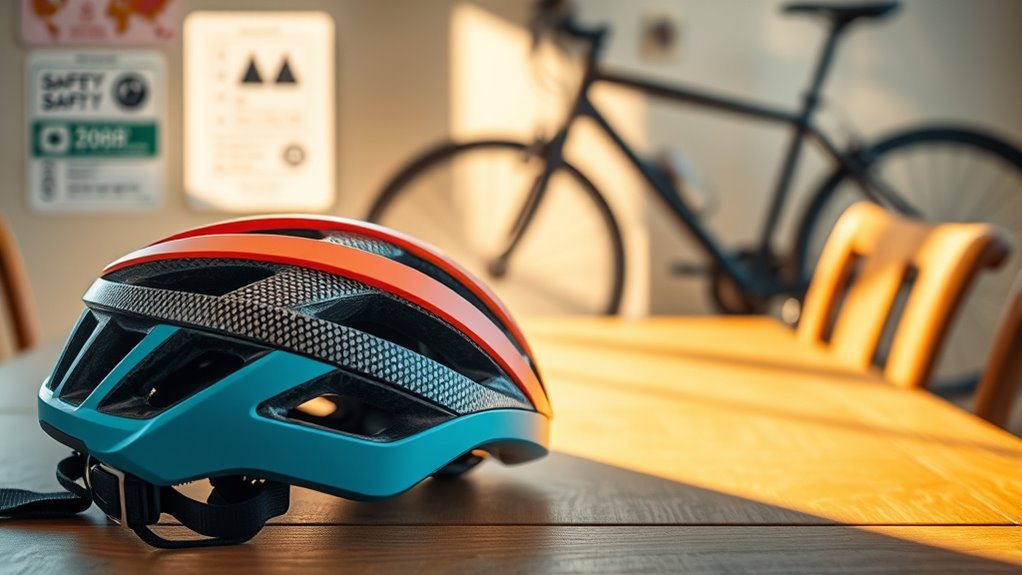
When choosing a bicycle helmet, it’s essential to understand the key safety standards that guarantee your protection. You’ll want to familiarize yourself with ASTM standards and CPSC compliance requirements, as these set the benchmarks for helmet safety. Knowing these standards can help you make an informed choice for your riding safety.
ASTM Standards Overview
Understanding ASTM standards is essential for anyone looking to guarantee their bicycle helmet meets safety requirements. The ASTM guidelines set specific criteria for helmet performance, ensuring they’re built from high-quality helmet materials. Adhering to these standards can greatly enhance your safety while riding.
Here’s a quick overview of key ASTM standards:
| Standard | Description |
|---|---|
| ASTM F1447 | Covers the requirements for road helmets, focusing on impact resistance. |
| ASTM F2032 | Addresses the safety of mountain bike helmets, emphasizing ventilation and durability. |
| ASTM F1163 | Targets equestrian helmets, ensuring they withstand falls and impacts effectively. |
CPSC Compliance Requirements
Ensuring your bicycle helmet complies with CPSC (Consumer Product Safety Commission) standards is essential for your safety on the road. CPSC regulations require helmets to meet specific impact resistance and performance criteria, which can greatly reduce the risk of head injuries. When shopping for a helmet, always check for proper helmet labeling, which indicates CPSC compliance. Look for the CPSC logo or label inside the helmet, confirming it’s been tested for safety. Remember, a helmet that meets these standards isn’t just a piece of gear; it’s your protection against unforeseen accidents. Choosing a CPSC-compliant helmet gives you the freedom to ride confidently, knowing you’ve made a smart choice for your safety. Stay safe and enjoy the ride!
How Helmets Are Tested
When it comes to helmet safety, testing is essential to guarantee protection. You’ll find that helmets undergo impact resistance testing, penetration resistance standards, and retention system evaluation to confirm their effectiveness. Understanding these testing methods helps you choose a helmet that truly meets safety requirements.
Impact Resistance Testing
Bicycle helmets undergo rigorous impact resistance testing to verify they can effectively protect riders in the event of a crash. These tests simulate various impact scenarios, confirming helmets absorb and dissipate energy during an accident. Testing methods typically involve dropping helmets from specific heights onto a rigid surface, mimicking the forces experienced during a fall. Helmets are evaluated for their ability to reduce the risk of head injury by measuring how much force is transmitted to the skull. Each model is subjected to multiple impacts at different angles, providing a thorough assessment of its safety. By adhering to strict standards, manufacturers help verify that when you hit the road, your helmet will stand up to the challenges you might face.
Penetration Resistance Standards
While impact resistance is essential for helmet safety, penetration resistance is equally important in protecting your head from sharp objects during a fall. To ascertain this, manufacturers conduct penetration testing, where a pointed object is dropped onto the helmet’s surface. This test measures the helmet’s ability to withstand sharp impacts, reflecting its material durability. Helmets must pass specific standards to guarantee they can effectively shield your head from potential hazards, assuring you can enjoy your ride without fear. Remember, a helmet that meets high penetration resistance standards not only protects against sharp objects but also enhances your overall safety. So, when choosing a helmet, look for those that excel in both impact and penetration resistance for maximum protection on your adventures.
Retention System Evaluation
Although a helmet’s material and design play essential roles in safety, the retention system is just as important, as it guarantees the helmet stays securely in place during a ride. Testing a helmet’s retention system involves evaluating how well the straps hold under various conditions. You’ll want to look for a helmet that features adjustable straps for a snug fit, which helps prevent it from shifting during an impact. Evaluators simulate crashes to determine if the helmet remains properly positioned on the head. A reliable retention system can make the difference between a helmet that protects you effectively and one that doesn’t. Always verify your helmet’s strap adjustment is correct before hitting the road, allowing you the freedom to ride with confidence.
What to Look for in a Helmet
When choosing a helmet, there are several key factors you should consider to guarantee maximum protection and comfort. First, verify the helmet fit is snug but not too tight. Next, explore various color options that match your style preferences, as a cool look can enhance your riding experience. Pay attention to padding materials for comfort during long rides, and don’t overlook the ventilation features to keep you cool. Additionally, consider weight considerations—lighter helmets are often more comfortable for extended use. Finally, check brand reputation and price ranges to make sure you’re investing in quality. A well-chosen helmet not only protects but also complements your freedom on the road.
Common Misconceptions About Helmet Safety
Many people mistakenly believe that wearing a helmet guarantees complete protection against all head injuries. This safety misconception can lead to a false sense of security. While helmets greatly reduce the risk of severe injury during a crash, they don’t eliminate the possibility of concussions or other head trauma. Furthermore, some think that any helmet will do the job, but that’s not true; the effectiveness varies by design and standards. Myths debunked include the idea that you don’t need a helmet if you’re riding slowly or on flat terrain. Remember, safety isn’t just about wearing a helmet; it’s also about safe riding practices. Understanding these points can empower you to enjoy your ride while prioritizing your safety.
Choosing the Right Helmet for Your Needs
How can you guarantee that you’re choosing the right helmet for your biking needs? Start by focusing on two main aspects: helmet fit and style preferences. A proper fit guarantees safety and comfort while you ride, so make certain the helmet sits snugly on your head without any wobbling.
Choosing the right helmet hinges on fit and style—ensure it sits snugly for safety and comfort while you ride.
Consider these factors:
- Size: Measure your head circumference to find the right size.
- Ventilation: Look for helmets with adequate airflow to keep you cool.
- Weight: Lighter helmets provide comfort for long rides.
- Style: Choose a design that reflects your personality and encourages you to wear it.
Frequently Asked Questions
How Often Should I Replace My Bicycle Helmet?
You should replace your bicycle helmet every three to five years, or sooner if it’s been in a crash—seriously, that helmet’s seen enough drama! Impact factors like temperature changes and wear can weaken its protective abilities. Following replacement guidelines is essential for your safety. Don’t wait until it’s too late; a fresh helmet can keep that adventurous spirit of yours soaring, ensuring you ride with confidence and freedom every time you hit the road!
Do Different Helmet Colors Offer More Safety?
Different helmet colors can impact your safety by influencing helmet visibility. Bright colors like neon yellow or orange stand out more against road backgrounds, making you more noticeable to drivers. While the color itself doesn’t enhance protection, increased visibility can help prevent accidents. So, when choosing a helmet, consider opting for vibrant shades. It’s a simple way to boost your safety while enjoying the freedom of the ride.
Can I Wear a Used Helmet Safely?
You can wear a used helmet safely, but there are essential steps to take first. Start with a thorough inspection—check for cracks, dents, or any signs of impact. Then, consider the helmet’s history; if it’s been in a serious crash, it’s best to replace it. Remember, a helmet’s effectiveness diminishes over time. So, if you’re unsure about its condition, it’s worth investing in a new one for your freedom on the road.
Are There Age-Specific Helmets for Children?
Yes, there are age-specific helmets designed for children. When choosing a helmet, it’s essential to take into account child helmet sizing to guarantee a proper fit. Youth helmet features often include adjustable straps and lightweight materials, making them comfortable for active kids. Proper sizing not only enhances safety but also encourages your child to wear their helmet more willingly. By prioritizing these aspects, you’re helping to keep your little ones safe while they enjoy their ride.
What Materials Are Commonly Used in Helmet Construction?
You’d think a helmet’s just a helmet, but it’s actually a complex mix of materials! Most helmets use expanded polystyrene foam (EPS) for shock absorption, while some might feature expanded polypropylene foam for flexibility. As for the shell, you’ll typically find polycarbonate or fiberglass, both of which offer durability and lightweight protection. It’s fascinating how these materials come together to keep you safe while you enjoy your freedom on the road!


